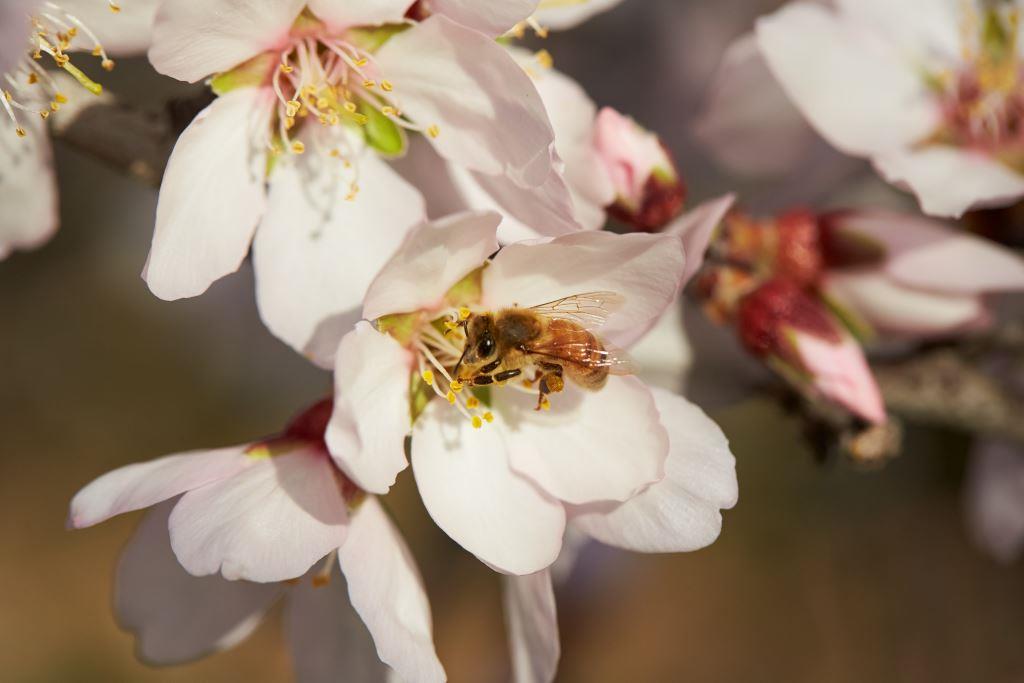 It would not be a stretch to say that billions of hard-working honey bees comprise the most important element in producing abundant California almond harvests.
It would not be a stretch to say that billions of hard-working honey bees comprise the most important element in producing abundant California almond harvests.
Of course, good soil, climate, water and other factors are crucial, but without the bees to pollinate our trees every spring, there would be no almonds. And without almond blossoms, the bees would lose their first vital source of nutritious natural pollen after a long winter. Strengthened by their stay in the almond orchards, bees move on to pollinate more than 90 other crops in our state and elsewhere in the nation.
The essential, age-old relationship between bees and almonds today represents the single largest managed pollination event in the world. Because it is so important to our state’s over 6,500 growers and many millions of almond-lovers worldwide, the Almond Board of California maintains a long-term commitment to ensuring that almond orchards are safe, healthy places for honey bees to forage while carrying vital pollen from tree to tree, blossom to blossom.
As part of our work on behalf of pollinator health, the Almond Board released last year a comprehensive set of Honey Bee Best Management Practices (BMPs) for our industry. They provide growers and other pollination stakeholders with a standardized toolkit of simple, practical, and research-based steps they can take to protect and promote bee health on their land and in the surrounding community.
Built on decades of work by the almond community, the BMPs include input from an array of experts, ranging from the growers and beekeepers to scientists, researchers, regulators and pesticide manufacturers. We have invested more in this issue than any other crop – funding over 80 research projects in our ongoing commitment to honey bee health. This includes researching issues like the Varroa mite and other honey bee pests; bee stock improvements and disease management; nutrition and honey bee forage; and the impact of pesticides and technical assistance for beekeepers.
The reaction to these BMPs represents another milestone in our effort to protect honey bee health and preserve the mutually beneficial relationship between honey bees and almonds.
We are seeing strong, favorable response and action by growers, beekeepers and others. In 2015, the Sacramento Bee acknowledged almond orchards as a safe haven and growers as allies to bees1. And Eric Mussen, Apiculturist Emeritus at UC Cooperative Extension, said that with the BMPs, the Almond Board is “responding strongly on honey bee health and, in particular, pesticide use and considerations during bloom.” He went on to say that the BMPs “go far beyond the almond orchard, providing important insights for all crops when it comes to promoting honey bee health."2
The BMPs particularly stress the value of communication and collaboration among everyone involved in pollination, including beekeepers, bee brokers, farm owners/lessees, farm mangers, pest control advisers and applicators, to be sure all are aligned when it comes to any activity that might put honey bees at risk.
The wide-ranging recommendations include information on providing clean water for bees to drink; timely removal of hives from orchards; using Integrated Pest Management (IPM) strategies to minimize agricultural sprays and exposure to honey bees; and addressing suspected pesticide-related honey bee losses.
Sporadic declines in honey bee health make the BMPs even more timely and essential. Experts have attributed health issues to a variety of factors including honey bee pests and diseases, decreasing sources of natural pollen, lack of genetic diversity and pesticide application practices – all addressed in the BMPs.
The Almond Board is a leader in the honey bee health conversation, a responsibility we take very seriously. We routinely engage with government and private organizations, the research community, beekeeping associations, our growers and others involved in pollination to share information, further our collective knowledge and promote action to strengthen honey bee health. And with our investment of $2.5 million to next-generation farming research, we will fund nine honey bee health projects this coming year, fueling the next round of innovation to ensure we continue to grow healthy, nutritious food, while protecting our pollinator partners.
To learn more about the Almond Board’s Honey Bee BMPs, visit Almonds.com/BeeBMPs.
1 Sacramento Bee, “Bees need allies beyond Big Almond.” March 21, 2015: http://www.sacbee.com/opinion/editorials/article15396410.html
2 Almonds.com, “Almond Board of California Announces Comprehensive Best Management Practices to Promote Bee Health.” October 16, 2014: http://www.almonds.com/growers/media-center/latest-news/2014/10/almond-board-california-announces-comprehensive-best
